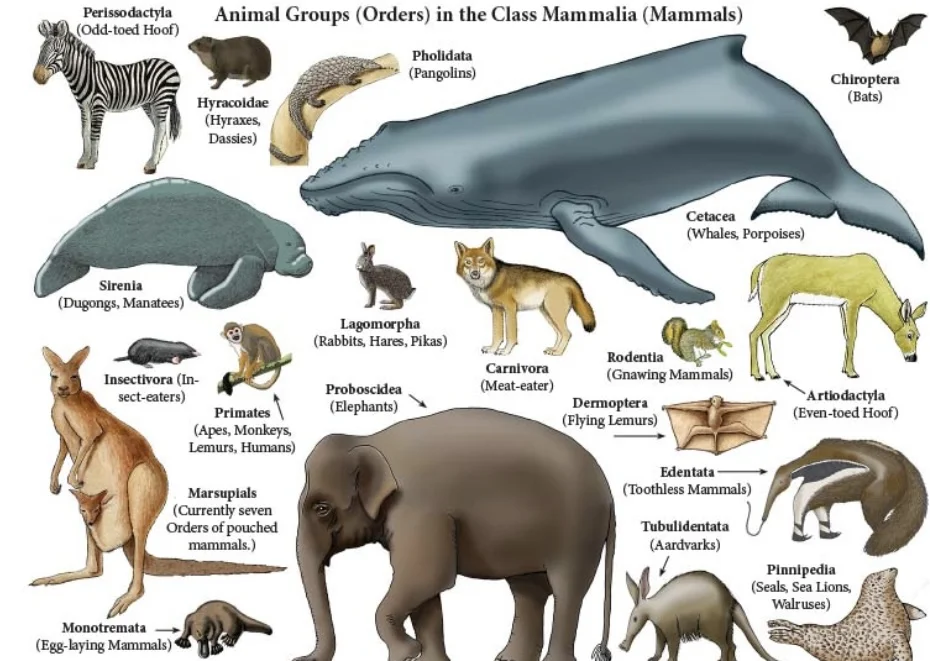
Exploring the Fascinating World of Animal Kingdom | Cambridge IGCSE Biology
[Please watch the video attached at the end of this blog for a visual explanation of this topic]
We learnt previously that according to the Linnaean System of Classification, we first divide organisms into Kingdoms, and under Features of Living Organisms we learnt about the Five Kingdoms that living organisms get classified into.
In this article, we will be focusing on one of those Kingdoms: the Animal Kingdom, or Kingdom Animalia, and the groups within the Animal Kingdom.
There are 23 Phylas (singular - Phylum) under the Animal Kingdom, but what is most important to you as an IGCSE student would be just 8:
- Phylum Coelenterata (Cnidaria)/ Coelenterates - sea anemones, jellyfish
- Phylum Platyhelminthes/ Flatworms - Tapeworms
- Phylum Nematoda/ Nematode worms - Ascaris, Wuchereria
- Phylum Annelida/ Annelids - segmented worms such as earthworms
- Phylum Arthropoda/ Arthropods - crustaceans, spiders, insects, etc
- Phylum Mollusca/ Molluscs - snails, octopi
- Phylum Echinodermata/ Echinoderms - starfish, sea urchins
- Phylum Chordata/ Vertebrates - fish, amphibians, mammals, etc.
Even out of these, the most important two Phyla that you will be learning about would be Phylum Arthropoda and Phylum Chordata.
The organisms in these two phyla are known as the arthropods and vertebrates respectively.
PHYLUM ARTHROPODA/ ARTHROPODS
The word arthropod comes from the Greek root words “arthro-” which means joint and “-pod” which means foot.
All arthropods are invertebrates. This means they do not have a backbone.
Apart from this, they all have two other special features. The first is that all arthropods have jointed legs (hence the name “arthropods”). The second feature is that all arthropods have an exoskeleton.
This phylum is further subdivided into groups known as Classes.
- Class Arachnida/ Arachnids
- Class Insecta/ Insects
- Class Crustacea/ Crustaceans
- Class Myriapoda/ Myriapods
Class Arachnida/ Arachnida
This term is taken from the Greek word ἀράχνη (aráchnē, ‘spider’), which comes from the myth where a human girl Arachne, whose occupation was a weaver, was turned into a spider (Percy Jackson, anyone?).
Arachnids include animals such as spiders, scorpions, ticks and so on. A closer look at an arachnid’s body shows that their body is made up of two parts: the abdomen and the cephalothorax. Furthermore, when counting the number of legs, you will see that arachnids have exactly four pairs of jointed legs, and that they don’t have any antennas!
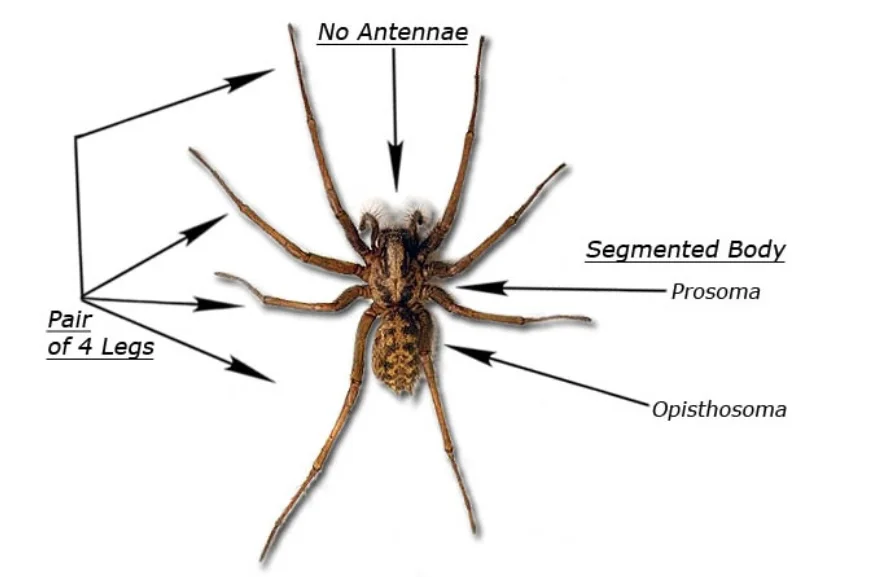
Opisthosoma - abdomen
Prosoma - united head and thorax together
(Picture from https://targetstudy.com/nature/animals/arachnids/ )
Class Crustacea/ Crustaceans
Crustaceans include animals like crabs, prawns, lobsters, etc. While most of them live in water, some crustaceans such as woodlice live on land.
Crustaceans have more than 4 pairs of jointed legs and their unique feature is their chalky and hard exoskeleton. This is because their exoskeleton is often calcified to become hard. Crustaceans breathe through gills and they all have two pairs of antennae. The crustaceans that live on land have modified gills that allow them to breathe air.
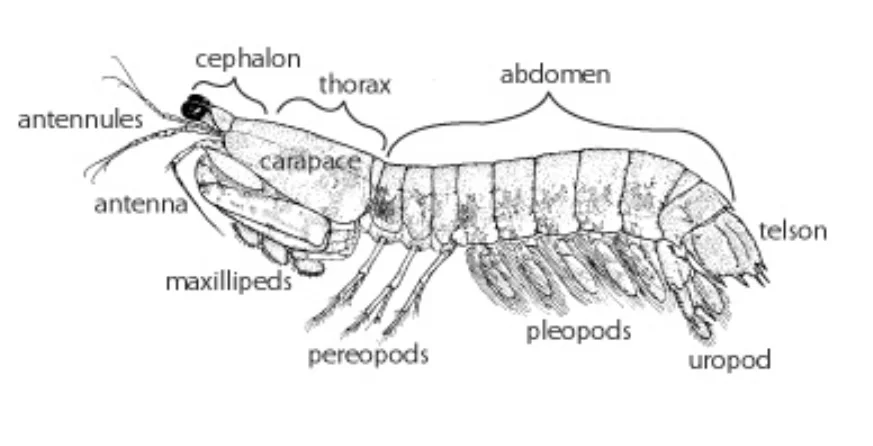
(Picture from https://ucmp.berkeley.edu/arthropoda/crustacea/crustaceamorphamm.html )
Class Insecta/ Insects
This is the largest class in Phylum Arthropoda, and insects include animals such as ladybugs, mosquitoes, flies, butterflies, ants, etc.
The body of an insect is made up of three parts: the head, the thorax and the abdomen, and when the number of legs are counted, it can be observed that they have exactly three pairs of jointed legs, one pair of antennae, and also two pairs of wings. Some insects do not have developed wings, with silverfish and fleas being some examples of wingless insects.
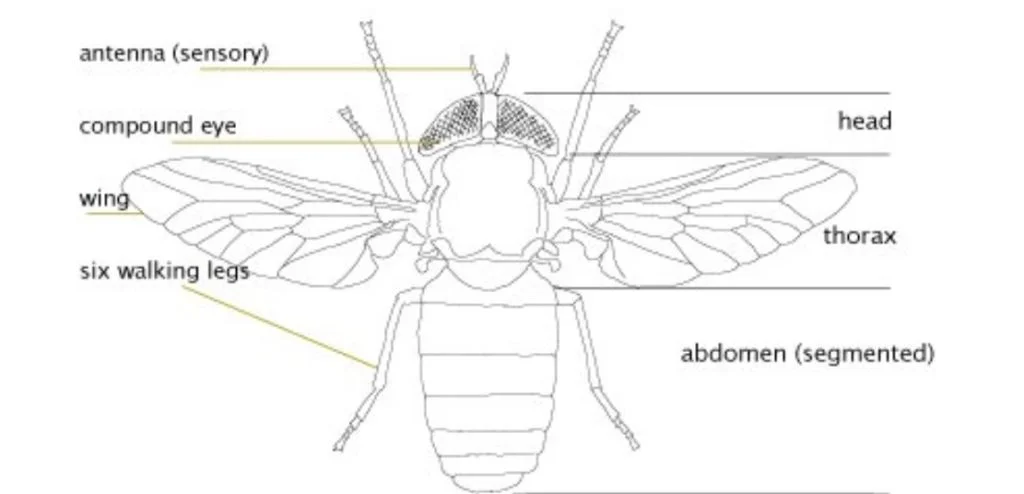
(Picture from https://australian.museum/learn/animals/insects/what-are-insects/)
Class Myriapoda/ Myriapods
Myriapods include the centipede and the millipede.
The myriapods are a group of arthropods who have long segmented bodies. Each segment will contain at least one pair of jointed legs and a closer look at a myriapod will show that it also has a pair of antennae.
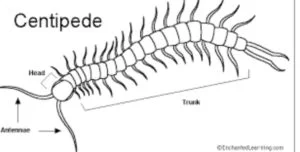
(Picture from https://arthropodinfo.weebly.com/myriapoda.html)
PHYLUM CHORDATA/ CHORDATES
This is the other phylum that is extremely important. This name comes from the Greek root word “chord-” meaning “string”. Most species within this phylum are vertebrates, or animals with backbones The only exceptions are two groups known as tunicates and lancelets, which are the only invertebrate groups within the phylum Chordata.
Subphylum Vertebrata/ Vertebrates
Vertebrates are a group of animals who have backbones, or a vertebral column.
There are 5 groups or classes of vertebrates:
- Fish
- Amphibians
- Reptiles
- Birds
- Mammals
Fish
Sharks, salmon, herrings, etc, all belong in this class.
Fish live in water, so they have wet, thick skin. They have loose wet scales on their skin, and breathe and respire through their gills. When it comes to reproduction, they lay eggs without shells in the water. Fish are ectotherms.
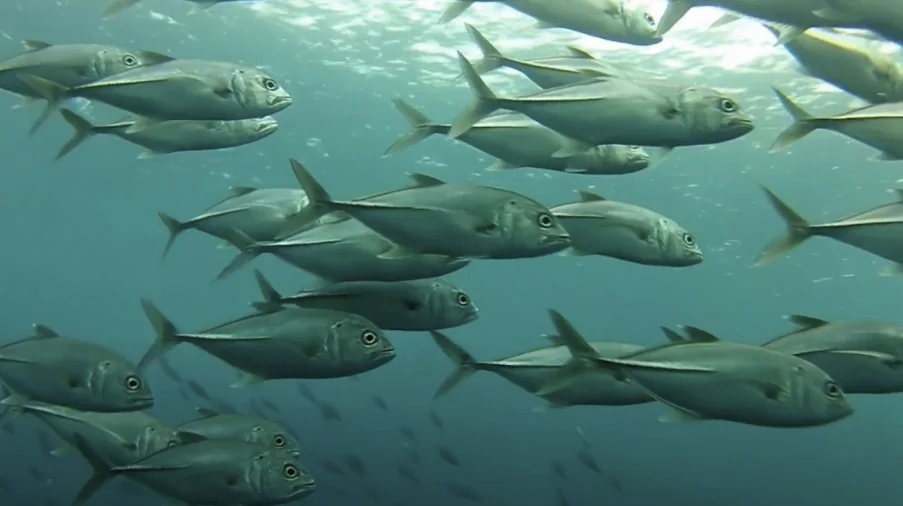
(Picture from https://accountability.fish/)
Amphibians
This includes animals like frogs, toads, the salamander, etc.
Amphibians have smooth, moist, slimy skin. Amphibianscan live both in water and on land. Amphibian young have gills and usually live in water, whereas adult amphibians have lost their gills and have lungs, therefore living on land. Hence, with regard to their respiration, the adults usually have lungs to breathe in and out, while the larvae usually have gills. Amphibians are ectotherms. Amphibians too lay eggs without shells in water, much like their friends the fish!
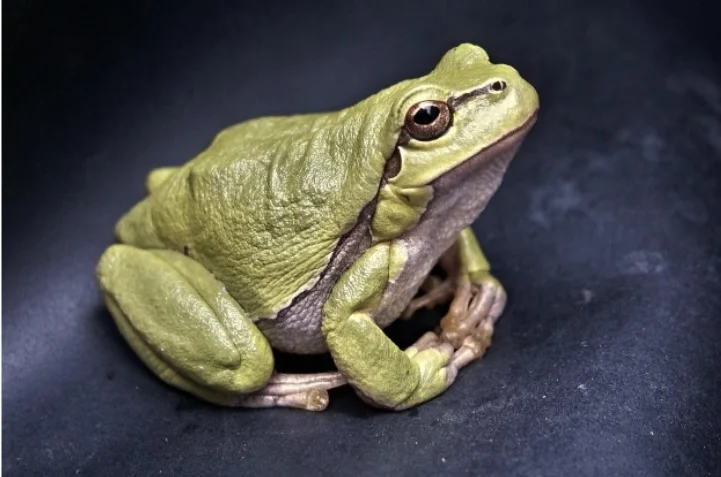
(Picture from https://www.twinkl.com.mx/teaching-wiki/frog)
Reptiles
This includes animals such as snakes, tortoises, lizards and so on.
All reptiles have dry, scaly skin. They too lay eggs, but unlike fish and amphibians, reptiles lay eggs on land. The shells of reptiles are often rubbery. Reptiles are ectotherms.
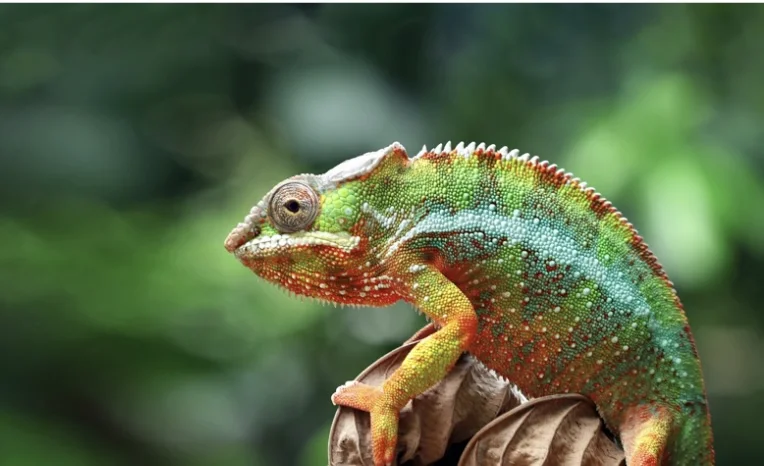 (Picture from https://www.frontiersin.org/journals/amphibian-and-reptile-science)
(Picture from https://www.frontiersin.org/journals/amphibian-and-reptile-science)
Birds
Birds are a unique group of animals. They are unique because they are the only animals who have feathers on their body and they are also the only animals that have a beak.
In addition to these two features, birds have two legs and two wings instead of four limbs. Birds also lay eggs on land (sometimes up in trees), however, instead of being rubbery, their egg shells are hard. Birds are endotherms.
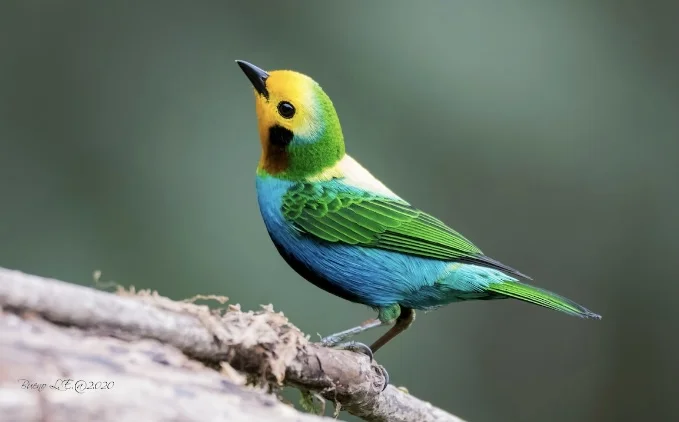 (Picture from https://birdsoftheworld.org/bow/news/welcome-to-bow)
(Picture from https://birdsoftheworld.org/bow/news/welcome-to-bow)
Mammals
Mammals are animals we are well familiar with, given that we humans are mammals as well. Apart from humans, tigers, elephants, cats, dogs, whales and dolphins (yes, you read that right!) are also mammals.
The most distinctive feature of mammals is how they feed their young ones. Mammalian young feed on milk created in the mammary glands of their mother.
Other features include having fur or hair on their skin, having a placenta, having external ears and also being endotherms.
(Picture from https://www.exploringnature.org/db/view/Class-Mammals-4th-Grade-and-up)
What does it mean to be an endotherm or an ectotherm?
When learning about the features of vertebrates, it was mentioned in each class that the animals were either ectotherms or endotherms. So what do these two phrases mean?
Ectotherms are ectothermic, which means they rely mainly on its external environment to regulate their body. Fish, amphibians and reptiles belong in this category. This is why you will see most reptiles basking in the sun.
Endotherms are endothermic. This means these animals are able to control or regulate their internal body temperature, by producing heat inside the body. Only two groups of vertebrates have this ability and they are birds and mammals.
Revising Kingdom Animalia
Since this is a subtopic under Characteristics and Classification of Living Organisms, make sure that you know your basics regarding Characteristics of Living Organisms and Classification.
This lesson is quite interesting and questions are of various types. Some questions can be found here as well, and you can time your answers to see if you can stick to the time limit given.
If you are struggling with IGCSE revision or Biology in particular, you can reach out to us at Tutopiya to join revision sessions or find yourself the right tutor for you.
Watch the video below for a visual explanation of the lesson and make sure to attempt the quiz later!
Written by
Tutopiya Team
Educational Expert
Related Articles

What’s Next After A-Levels? Figuring Out Your Next Step
Comprehensive guide and expert insights on educational topics for IGCSE, IB, and international curriculum students.

IGCSE Economics Revision Resources, Past Papers, and More
Master IGCSE Economics with essential revision resources & past papers. Ace your exams with global support. Ideal for IB & A-level students too.

Why Personalized Learning Beats Group Classes for IGCSE
Comprehensive guide and expert insights on educational topics for IGCSE, IB, and international curriculum students.

